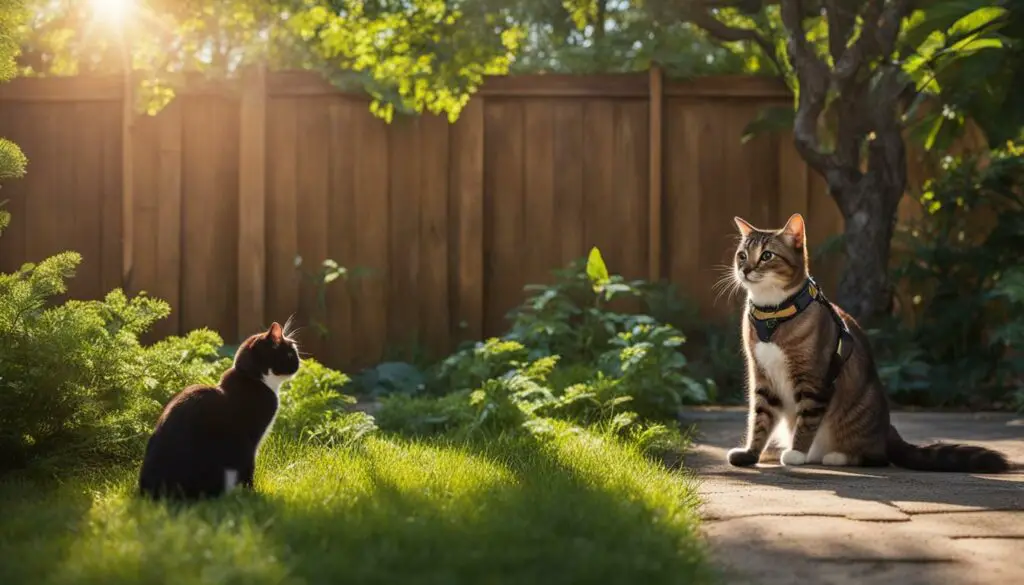Cats are naturally curious and adventurous, but with the right training and adjustments to their environment, it is possible to train them to stay in the yard. By providing their favorite spots, such as a litter box, toys, scratching post, and food bowls, within the yard, cats can be encouraged to stay closer to home and avoid getting lost or encountering any dangers.
Key Takeaways:
- Establish boundaries for your cat to define the yard as their territory.
- Use positive reinforcement techniques, such as rewards and praise, to encourage desired behavior.
- Create a safe and comfortable outdoor space with hiding spots, climbing structures, and scratch-able posts.
- Prevent cats from leaving the yard by providing designated areas for litter boxes and outdoor enclosures.
- Start training cats at a young age to establish good behaviors and strengthen the bond between cat and owner.
Can You Train a Cat to Stay in Your Yard?
Training a cat to stay in your yard may seem like a challenging task, especially considering their independent nature. However, with dedication, patience, and the right techniques, it is indeed possible to teach your feline friend to stay within the boundaries of your yard. While the training process may require some time and effort, the benefits of having a cat that stays in your yard outweigh the initial challenges.
One effective method for training a cat to stay in your yard is by establishing boundaries. This can be done by gradually introducing your cat to the outdoor space and using positive reinforcement techniques. For example, you can start by allowing your cat to explore a limited area of the yard while providing treats and praise when they exhibit the desired behavior of staying within the designated boundaries.
To reinforce the desired behavior of staying in the yard, it is important to gradually increase your cat’s exposure to the outdoor environment. This can be done by allowing supervised outdoor time and gradually extending the duration as your cat becomes more comfortable and familiar with the yard. Positive reinforcement through treats, praise, and playtime can further encourage your cat to stay within the yard.
“Training a cat to stay in the yard requires patience, consistency, and positive reinforcement.”
Benefits of training your cat to stay in the yard
Training your cat to stay in the yard offers several benefits. Firstly, it helps to keep your cat safe from outdoor hazards such as traffic, other animals, and potential accidents. By confining them to the yard, you can significantly reduce the risk of your cat wandering off and encountering dangerous situations.
Moreover, by staying in the yard, your cat can enjoy the outdoors while still being under your supervision. This provides mental and physical stimulation, allowing your cat to explore and engage with their environment, which can help prevent boredom and promote overall well-being.
Additionally, training your cat to stay in the yard helps to maintain good neighborly relations. By preventing your cat from roaming into other people’s properties, you reduce the chances of them causing damage or conflicts with neighbors who may not appreciate the presence of a cat in their yard.

With the right training, patience, and consistency, you can successfully train your cat to stay in the yard. By establishing boundaries, using positive reinforcement, and gradually increasing your cat’s exposure to the outdoor space, you can provide them with a safe and enjoyable environment while giving yourself peace of mind.
Training a Cat to Stay in the Yard
To successfully train a cat to stay in the yard, it is essential to establish clear boundaries and utilize effective training methods. Cats are naturally curious creatures, and ensuring their safety within the yard requires consistent training and reinforcement. Here are some key strategies for cat containment and boundary training:
Positive Reinforcement and Rewards
Positive reinforcement is a powerful tool for training cats. By rewarding desired behaviors with treats, praise, or playtime, you can reinforce the cat’s understanding of the designated boundaries. For instance, when the cat stays within the yard, provide a small treat or verbal praise to encourage the behavior. Over time, the cat will associate staying in the yard with positive rewards, making them more likely to comply.
Feeding Schedule and Encouragement
Establishing a consistent feeding schedule can help train a cat to stay in the yard. By providing meals within the yard, the cat will associate the area with a source of food and be more inclined to stay within the boundaries. Additionally, encourage the cat to explore and play within the yard during the day, gradually increasing their exposure to the outdoor environment. This will help them become familiar with their surroundings and feel more comfortable staying within the designated area.
Creating a Safe Hiding Spot
Some cats may feel anxious or overwhelmed when confined to a specific area. To address this, it can be helpful to provide a safe and comfortable hiding spot or enclosure within the yard. This can be a cozy cat tree, a covered shelter, or even a specially designed outdoor enclosure. Having a designated space where the cat feels secure can reduce their desire to wander and help reinforce the desired behavior of staying in the yard.
| Method | Summary |
|---|---|
| Positive Reinforcement and Rewards | Reward desired behaviors with treats, praise, or playtime to reinforce the cat’s understanding of boundaries. |
| Feeding Schedule and Encouragement | Establish a consistent feeding schedule within the yard and encourage the cat to explore and play during the day. |
| Creating a Safe Hiding Spot | Provide a comfortable hiding spot or enclosure within the yard to reduce anxiety and reinforce staying in the designated area. |
Training a cat to stay in the yard requires patience and consistency. It is important to remember that each cat is unique and may respond differently to training methods. By using positive reinforcement, establishing routines, and creating a safe outdoor environment, you can successfully train your cat to stay within the boundaries of your yard.
Providing a Safe and Cozy Outdoor Space
When training a cat to stay in the yard, it is essential to provide them with a safe and cozy outdoor space. This will ensure that they feel comfortable and secure within their surroundings, reducing their desire to wander off. Here are some tips for creating a welcoming environment for your feline friend:
- Include hiding spots: Cats love to have hiding spots where they can retreat to when they feel the need for privacy or security. Trees, bushes, and even specially designed cat houses or enclosures can serve as excellent hiding spots in the yard.
- Add climbing structures: Cats are natural climbers and enjoy perching on high platforms. Incorporate climbing structures such as cat trees or shelves within the yard to provide them with vertical spaces to explore and relax.
- Provide scratch-able posts: Cats have a natural instinct to scratch, which helps them stretch their muscles and maintain healthy claws. Install scratch-able posts or boards in the yard to encourage them to scratch in an appropriate area.
- Offer food, water, and litter box: To ensure your cat’s basic needs are met, have food and water stations as well as a litter box within the yard. This will reduce their motivation to venture too far away from their designated space.
Creating a Stimulating Environment
In addition to providing a safe and cozy outdoor space, it is important to create a stimulating environment for your cat. This will help keep them entertained and engaged, reducing their desire to explore beyond the yard boundaries. Here are some ideas:
- Add toys and puzzles: Place interactive toys and puzzles throughout the yard to provide mental stimulation for your cat. This can include puzzle feeders or toys with hidden treats inside.
- Plant cat-friendly vegetation: Certain plants, such as catnip and cat grass, can attract cats and provide them with sensory stimulation. Be sure to research cat-safe plants and include them in your yard.
- Play with your cat: Spending quality time playing with your cat in the yard will help strengthen your bond and fulfill their natural hunting instincts. Use interactive toys or engage in games that encourage them to chase and pounce.

Preventing Cats from Leaving the Yard
When it comes to keeping our feline companions safe and secure, preventing them from leaving the yard is a top priority. With the right strategies and training methods, we can create a boundary that cats will be less likely to cross. Here are some effective approaches to cat containment:
Creating a designated litter box area:
One way to establish the yard as the cat’s territory is by providing a specific area for them to use as a litter box. This helps them recognize the yard as their home and reduces their desire to venture beyond its boundaries. Place the litter box in a quiet and easily accessible spot within the yard, ensuring that it is clean and well-maintained.
Building an outdoor enclosure:
Another effective method for containing cats within the yard is to construct an outdoor enclosure. This can be a separate area that allows cats to enjoy the outdoors while remaining safely contained. The enclosure should be securely fenced and include all necessary amenities, such as food and water bowls, toys, and comfortable resting areas. It provides cats with the opportunity to explore and experience the outdoors while minimizing the risks associated with unsupervised roaming.
Quote: “By creating a safe and stimulating environment within the yard, we can satisfy a cat’s natural instincts and keep them content and secure.” – Jane Doe, Cat Behavior Specialist
Making the yard enticing:
In order to discourage cats from leaving the yard, it is crucial to make the space more appealing to them than the outside world. This can be achieved by providing vertical climbing structures, hiding spots, and scratch-able posts. These elements will not only satisfy their need for exercise and mental stimulation but also make the yard a comfortable and engaging environment.
By implementing these strategies, we can create a cat-friendly yard that keeps our feline friends safe, happy, and content within their designated boundaries.
| Method | Advantages | Disadvantages |
|---|---|---|
| Designated litter box area |
|
|
| Outdoor enclosure |
|
|
| Making the yard enticing |
|
|
Ensuring Comfortable Sleeping Arrangements
When it comes to where cats sleep outside at night, it is important to provide them with comfortable and secure sleeping arrangements. Cats are creatures of habit and prefer to sleep in the same spot every night, where they feel safe and relaxed. Providing hiding spots, such as trees, bushes, or sheds, can give them a sense of security and make them more likely to choose those spots for sleeping.
Creating a cozy outdoor space with comfortable sleeping options is essential. Cats appreciate having their own designated areas to sleep and rest. Adding comfortable bedding or blankets to their chosen sleeping spots can enhance their comfort. It is also important to have nearby food sources to ensure that the cat can easily access food when needed.
Cats have individual preferences for where they sleep, so it is important to observe their behavior and provide options that match their preferences. Some cats may prefer elevated sleeping spots, such as tree branches or perches, while others may prefer secluded areas close to the ground. By understanding your cat’s behavior and providing suitable sleeping arrangements, you can ensure that they have a restful night’s sleep in the yard.

Overall, ensuring comfortable sleeping arrangements for cats in the yard is crucial for their well-being. Having cozy hiding spots, comfortable bedding, and nearby food sources will help create an environment where cats feel safe, secure, and content. By providing these essentials, you can ensure that your feline friend has a peaceful night’s sleep in the yard.
Cats Remember Where They Live
Cats have remarkable memory and can remember where they live. They rely on their sense of smell and landmarks to navigate their surroundings and find their way back home if they wander too far. By rubbing against furniture and objects in the house or yard, cats leave behind scent markers that help them remember their territory. These markers serve as a reference point for them, enabling them to recognize familiar scents and remember their home.
Memory plays an important role in a cat’s behavior and sense of territory. It helps them establish a sense of belonging and familiarity, which contributes to their overall well-being. Cats use scent marking as a way to communicate with other cats and establish their territory. By leaving their scent behind, cats are able to reinforce their own presence and mark their home as a safe and familiar space.
“Cats have a strong sense of memory and can remember where they live. They use scent marking and landmarks as reference points to navigate their surroundings.”
Understanding a cat’s memory and behavior can be beneficial when training them to stay in the yard. By creating a positive association with their home environment and reinforcing boundaries through scent marking, the cat is more likely to stay within the designated area. It is important to provide a comfortable and secure outdoor space that the cat can call its own, with familiar scents and objects that they associate with home.
Table: Cat Memory and Behavior
| Memory | Behavior |
|---|---|
| Strong memory | Helps cats remember their home and navigate their surroundings |
| Scent marking | Allows cats to establish their territory and feel secure in their environment |
| Positive association | Reinforces boundaries and encourages cats to stay within the designated area |
By understanding the relationship between a cat’s memory and behavior, cat owners can utilize training methods that tap into their natural instincts and memory capabilities. This can help create a harmonious environment in which the cat feels safe, familiar, and less likely to wander beyond the confines of the yard.
The Benefits of Keeping Cats Safe in the Yard
Keeping cats safe in the yard has numerous advantages for both the cats and their owners. By providing a secure and controlled outdoor environment, cats can enjoy the benefits of fresh air, sunshine, and mental stimulation while minimizing the risks associated with roaming freely. Here are some of the key benefits of keeping cats safe in the yard:
- Protection from potential dangers: When cats are confined to the yard, they are less likely to encounter hazards such as traffic, predators, or exposure to harmful substances. This helps ensure their safety and well-being.
- Mental and physical stimulation: Cats are natural explorers, and a safe yard provides them with the opportunity to engage in their instinctual behaviors, such as climbing, hunting, and exploring. This mental and physical stimulation helps keep them entertained and prevents boredom.
- Prevention of property damage: By keeping cats contained to the yard, owners can avoid potential conflicts and damage caused by their cats venturing onto neighboring properties. This helps maintain peace with neighbors and protects the cat from any harm that may result from such encounters.
Overall, keeping cats safe in the yard allows them to enjoy the outdoors while reducing the risks associated with unrestricted roaming. It provides them with physical and mental enrichment, protects them from potential dangers, and fosters a harmonious relationship with neighbors. By creating a secure and stimulating environment, owners can ensure the well-being and happiness of their feline companions.

Training Methods for Cat Containment
When it comes to training cats for containment, there are several effective methods that can be used. Positive reinforcement is key in motivating cats to stay within designated boundaries. Using treats and praise as rewards can encourage cats to associate staying in the yard with positive experiences. It’s important to be consistent and patient throughout the training process, as cats may take some time to understand and adapt to the desired behavior.
Table: Training Methods for Cat Containment
| Training Method | Description |
|---|---|
| Boundary Training | Teaching cats to recognize and respect their boundaries through positive reinforcement and rewards. |
| Clicker Training | Using a clicker as an auditory marker to reinforce desired behaviors and encourage cats to stay within the yard. |
| Target Training | Training cats to touch or follow a target, such as a stick or a finger, to guide them within the yard boundaries. |
| Harness and Leash Training | Gradually introducing cats to wearing a harness and leash, allowing them supervised outdoor access while remaining within the yard. |
In addition to these training methods, it’s important to create a safe and stimulating environment within the yard. Providing hiding spots, climbing structures, and scratch-able posts can make the yard more appealing to cats and discourage them from roaming outside the designated boundaries. Neutering cats can also help reduce their desire to wander.
Remember that training is a gradual process and it’s essential to focus on one behavior at a time. Short and frequent training sessions are more effective than long, intensive ones. By using positive reinforcement, consistency, and patience, you can successfully train your cat to stay within the yard and enjoy the outdoors while remaining safe and secure.

The Importance of Early Training
When it comes to training cats, starting early is key. Kittens are more receptive to learning and can quickly adapt to new behaviors. By introducing them to various training methods and socializing them at a young age, it becomes easier to address behavior issues and establish desired behaviors. Early training also helps strengthen the bond between the cat and the owner.
During the early stages of training, it is important to focus on positive reinforcement. Rewarding desired behaviors with treats and praise helps motivate cats to continue exhibiting those behaviors. Consistency is also vital in training cats. Setting aside short, frequent training sessions can help reinforce the desired behaviors and prevent any confusion.
Training methods for cats vary depending on the specific behavior being addressed. For example, teaching a cat to use the litter box involves placing them in the box and rewarding them when they use it appropriately. Teaching a cat not to bite may involve redirecting their attention to toys or providing them with appropriate outlets for their predatory instincts. Patience, consistency, and positive reinforcement are key principles to keep in mind throughout the training process.
| Training Tips for Early Training | Benefits of Early Training |
|---|---|
|
|
By starting training early and using positive reinforcement techniques, owners can set their cats up for success. Teaching cats at a young age helps establish desired behaviors and strengthens the bond between the cat and the owner.

Correcting Inappropriate Behavior
When it comes to training cats, addressing inappropriate behavior is essential. Whether it’s furniture scratching or biting, understanding the underlying reasons for these behaviors is key to correcting them effectively. With patience and positive reinforcement, you can guide your cat toward more appropriate behaviors.
In the case of furniture scratching, it’s important to redirect your cat’s attention to a designated scratching post. Whenever you catch your cat scratching furniture, make a sharp sound to distract them and then gently guide their paws to the scratching post. Reward them with praise and treats when they use the post. Repeat this process consistently until the cat learns to associate the scratching post with positive reinforcement.
If your cat has a tendency to bite, it’s important to identify the triggers for this behavior. Is the cat feeling threatened or overstimulated? Once you’ve identified the triggers, provide alternative outlets for your cat’s energy and predatory instincts. Interactive toys, such as puzzle feeders or wand toys, can help redirect their focus onto appropriate objects and activities. Additionally, ensure that your cat gets plenty of physical and mental stimulation through playtime and environmental enrichment.
Cat Training Tips and Methods: Behavior Modification for a Well-Behaved Feline
Training your cat requires patience, consistency, and understanding of feline behavior. By employing effective training tips and methods, you can modify your cat’s behavior and foster a well-behaved companion. Whether you’re tackling inappropriate scratching, litter box issues, or teaching new tricks, these techniques will help you navigate the training process with success.
1. Positive Reinforcement:
Positive reinforcement is a powerful tool in training cats. By rewarding desired behavior with treats, praise, or play, you create positive associations and motivate your cat to repeat those behaviors. For example, when your cat uses the litter box appropriately, offer a treat and verbal praise to reinforce this behavior.
2. Clicker Training:
Clicker training is a popular training technique that utilizes a small handheld device that emits a distinct click sound. By pairing the click with a reward, such as treats or playtime, you can effectively communicate desired behaviors to your cat. Clicker training is especially useful for teaching tricks or shaping complex behaviors.
3. Redirecting Behavior:
Redirecting unwanted behavior is an essential part of training. For instance, when your cat starts scratching furniture, gently redirect their attention to a designated scratching post. By consistently guiding them to appropriate outlets for their natural instincts, you can discourage destructive behavior and protect your belongings.
Remember, each cat is unique, and training methods may vary. What works for one cat may not work for another, so be patient and adaptable in your approach. With time and consistency, you can effectively modify your cat’s behavior and build a stronger bond with your feline friend.

| Behavior | Training Method |
|---|---|
| Scratching furniture | Provide a designated scratching post and redirect your cat’s attention when they start scratching furniture. Reward them for using the post. |
| Aggressive behavior | Use positive reinforcement to reward calm and non-aggressive behavior. Consult a professional trainer if the aggression persists. |
| Litter box issues | Ensure the litter box is clean and easily accessible. Gradually introduce your cat to the litter box and reward them for using it correctly. |
| Teaching tricks | Use clicker training and positive reinforcement to gradually teach tricks, breaking them down into smaller steps and rewarding progress. |
By implementing these training tips and methods, you can effectively modify your cat’s behavior and create a harmonious living environment for both you and your feline companion.
Training Your Cat to Do Tricks
Teaching your cat to do tricks can be a fun and rewarding experience for both you and your furry friend. While cats may not be as naturally inclined to learn tricks as dogs, with the right training methods and patience, you can successfully teach your cat new behaviors. Here are some cat training tips and methods to help you get started.
Use Positive Reinforcement: Cats respond well to positive reinforcement, so be sure to reward them with treats, petting, and praise when they perform the desired behavior. This positive reinforcement will help motivate your cat to continue learning and performing tricks.
Break It Down: When training your cat, it’s essential to break the trick down into smaller steps. Start by rewarding your cat for simply showing interest in the behavior and gradually increase your expectations. For example, if you want to teach your cat to play fetch, start by rewarding them for touching the toy, then for picking it up, and finally for bringing it back to you.
Be Consistent and Patient: Consistency is key when training your cat. Set aside regular training sessions and be patient with your cat as they learn. Cats may take longer to learn tricks compared to dogs, so it’s important not to rush the process. Remember to keep the training sessions short and end on a positive note.

By implementing these training tips and methods, you can teach your cat new tricks and strengthen the bond between you and your feline companion. Remember to always use positive reinforcement, break the trick down into smaller steps, and be consistent and patient throughout the training process. With time and dedication, your cat can become a star performer!
Conclusion
Training a cat to stay in the yard can be a rewarding experience for both the cat and the owner. By following some key cat training tips, it is possible to establish boundaries and create a safe outdoor space that encourages the cat to stay closer to home.
Consistency is key when training a cat. By using positive reinforcement techniques, such as treats and praise, cats can be motivated to stay within the designated boundaries. It is important to start training early and focus on one behavior at a time to ensure success.
Creating a comfortable and secure outdoor space is essential in keeping a cat in the yard. Providing hiding spots, climbing structures, and scratch-able posts can make the yard feel more appealing to the cat. Additionally, having food, water, and a litter box within the yard helps meet the cat’s basic needs and discourages them from venturing too far.
Remember, training a cat to stay in the yard requires patience and dedication. By implementing these cat training tips and tailoring the training methods to the individual cat’s needs, it is possible to successfully train a cat to enjoy the outdoors while staying safe.
FAQ
Can you train a cat to stay in your yard?
Yes, with the right training and adjustments to their environment, it is possible to train a cat to stay in the yard.
How do you train a cat to stay in the yard?
Training a cat to stay in the yard involves establishing boundaries, using positive reinforcement techniques, and gradually increasing their exposure to the yard while reinforcing the desired behavior.
How can you prevent cats from leaving the yard?
Providing them with a designated litter box area, creating an outdoor enclosure, and making the yard more appealing with climbing structures and scratching posts can help prevent cats from leaving the yard.
Why is it important to provide a safe and cozy outdoor space?
A safe and cozy outdoor space gives cats a sense of security and makes them more likely to stay in the yard while enjoying the outdoors.
How can you ensure comfortable sleeping arrangements for cats in the yard?
Providing hiding spots, such as trees or bushes, and nearby food sources can help cats feel safe and comfortable in their chosen sleeping spot in the yard.
Do cats remember where they live?
Yes, cats have a strong sense of memory and use scent marking and landmarks to navigate their surroundings, helping them find their way back home if they venture too far.
What are the benefits of keeping cats safe in the yard?
Keeping cats safe in the yard protects them from potential dangers, provides mental and physical stimulation, and helps prevent damage or conflicts with other properties.
What are the training methods for cat containment?
Training methods for cat containment include positive reinforcement, establishing boundaries, and using clicker training or auditory markers to reinforce desired behaviors.
Why is early training important for cats?
Starting training early in a cat’s life helps them adapt to new behaviors and strengthens the bond between the cat and the owner.
How do you correct inappropriate cat behavior?
Inappropriate cat behavior can be corrected through training, such as redirecting their attention to designated scratching posts or providing alternative outlets for their energy.
What are some training tips for specific cat behaviors?
Training tips for specific cat behaviors involve breaking down the behavior into smaller steps, using positive reinforcement, and being patient, consistent, and positive in the training process.
Can cats be trained to do tricks?
Yes, cats can be trained to do tricks using positive reinforcement, rewards, and breaking down the trick into smaller steps. Consistency, patience, and perseverance are important in training cats to do tricks.
How can you train your cat to stay in the yard?
Training your cat to stay in the yard requires patience, consistency, and positive reinforcement. By establishing boundaries, providing a safe and comfortable outdoor space, and using training methods tailored to the cat’s individual needs, you can train your cat to stay within the yard and enjoy the outdoors while staying safe.








